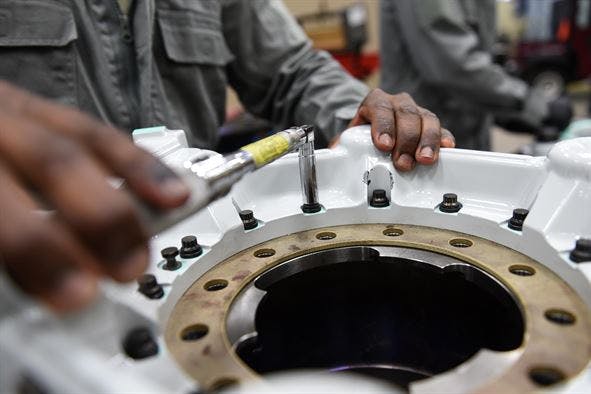When your hydraulic equipment fails, there is no time to waste getting it working again. You have the option to repair, replace, or rebuild hydraulic equipment — but which should you choose? More and more companies are opting to rebuild hydraulic equipment rather than purchase new components or have the existing components repaired. Let’s discuss what a rebuild is and why rebuilds are an increasingly popular choice so that you can make an informed decision the next time you face a hydraulic equipment failure.
What Is an Equipment Rebuild?

While the exact definition of a rebuild can vary from shop to shop, a rebuild typically is a piece of equipment that has been used previously and reconditioned for further use. Expert rebuilders can not only restore a piece of equipment to OEM specifications, they can often exceed the quality of a brand-new machine. A rebuild differs from a repair, where the primary focus is on fixing the individual parts involved in failure. It is also very different from purchasing used equipment, which usually has not been refurbished or reconditioned.
To properly rebuild a piece of equipment, it is completely disassembled so that each individual piece can be inspected. The parts are evaluated for wear, damage, and effect on the overall life of the component. Replacement and reconditioning of parts is performed as needed, the component is reassembled, and then it undergoes thorough quality and performance testing.
It’s Less Expensive to Rebuild Hydraulic Equipment

One of the first reasons that rebuilds are increasing in popularity is, of course, the lower cost. A rebuild typically costs about half of the price of a new piece of equipment, and this includes components like hydraulic motors and pumps. While repairs may initially be cheaper, it’s only a matter of time before the equipment fails and repairs are once again needed.
In the long run, rebuilds usually end up being cheaper than repairs and are certainly less expensive than purchasing new replacement parts.
Rebuilds Are High Quality
While rebuilt equipment has been used previously, it represents exceptional value. When equipment is rebuilt, it goes through a rigorous process that includes the replacement of seals and bearings, evaluating individual parts for their remaining life expectancy, replacing parts that are irreparably damaged, and restoring parts that can be refurbished.
The result is a hydraulic pump or hydraulic motor that is like new — and maybe even better than new. It can have a lifespan of at least 75% of a brand new motor or pump, but again, at about half the price.
Rebuilds Involve Shorter Lead Times

Choosing to rebuild hydraulic equipment over purchasing new equipment is often the decision when time is of the essence. A certified rebuild usually involves a much shorter lead time, typically because there is significant time that is spent waiting for a replacement part to possibly be manufactured and then delivered. The longer the wait for replacement parts, the longer machines are down, which creates production cost issues and downtime for employees.
When these issues are factored in, rebuilds often are clearly the most economical option. A rebuilt component, such as a cylinder or motor, can be refurbished immediately, minimizing the downtime of the equipment and staff involved.
Rebuilds are More Environmentally Friendly

An additional consideration when choosing whether to repair, replace, or rebuild hydraulic equipment is the environmental impact of your decision. Rebuilding hydraulic equipment is clearly the most environmentally friendly option.
Consider, for example, a hydraulic motor. Think about the energy that goes into smelting the iron, processing it into steel, shaping the steel and other metals to make each component of the motor, and then shipping it to distributors. In most rebuilds, only a limited number of parts need replacement, and those typically don’t include the largest parts, such as the hub. This alone will significantly reduce the energy involved for manufacturing.
Not all of the remaining parts will need reconditioning, either. And for those that do, reconditioning processes such as lapping require far less energy than what is needed to make the part from scratch. Even shipping a rebuild has less impact on the environment, since the rebuilt motor is sent directly to the customer rather than to a distributor’s warehouse first.
In short, the energy required for a hydraulic motor rebuild is significantly less than what is needed to manufacture a new hydraulic motor with less waste ending up in landfills. All in all, making the choice to rebuild hydraulic equipment is a “greener” option.
Let the Experts Rebuild Your Hydraulic Equipment

At MAC Hydraulics, we offer solid rebuilds that provide your equipment with the quality and lifespan that you need at a price that you can afford. We perform rebuilds quickly so that your company will be back in business in no time. We also offer rebuild and repair services for cylinders, pumps, gears, motors, valves and other hydraulic components. We work on motor brands including Eaton, Danfoss, and Char-Lynn and pump brands that include Vickers, Parker, Permco, and Sundstrand. We also service relief valves, spool valves, directional control valves, and counterbalance valves.
Our skilled technicians can troubleshoot, rebuild, repair, install, and maintain your equipment on a preventative maintenance schedule. We offer on-site service, and our trucks are loaded with the parts and tools needed to keep your equipment running at peak performance. Give MAC Hydraulics a call today!

